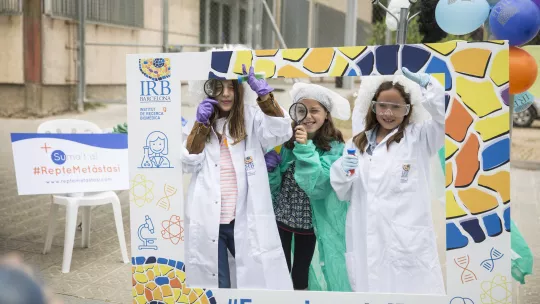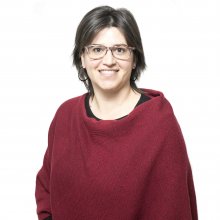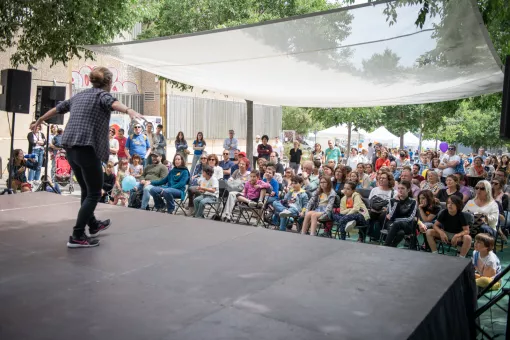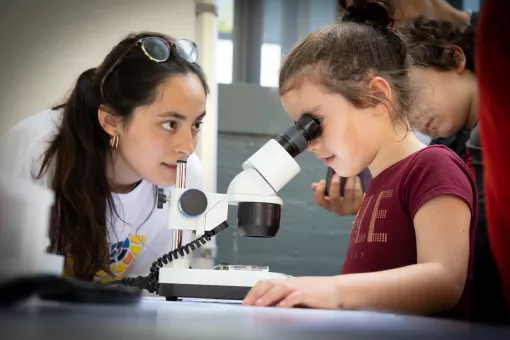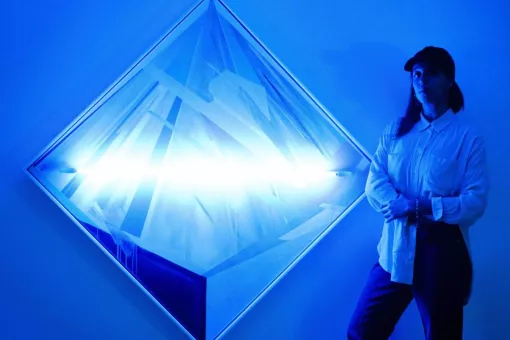Images
Personal chronicle of the day by Tanya Yates
Although the event itself is not due to start till 10 am, at 7 am a small group of sleepy people from the Communications Department (including me) are already busy with the logistics of the event. Bit by bit, our eager “crazies” (different generations of our Crazy About Biomedicine programme for secondary school students) start to arrive, PhD students turn up to organise the multiple stands in the Science Fair, admin staff take up duties at the registration desk… it’s 10 am. I love punctuality!
People start to trickle down the street. It’s slow to begin with but after 25 minutes there is a queue at the registration desk, and people are starting to head off to activities inside and outside the building. Lively music is blasting out of the loud speakers on the stage to get everyone into the spirit of things.
I go into the building to check out the first Scientific Talk, by Eduard Batlle. The room is full and the silence of people concentrating is absolute. A gifted public speaker, Eduard, skilfully transmits the science and the challenges ahead in his line of cancer research and explains how everyone can get involved by joining IRB Barcelona’s #MetastasisChallenge. Batlle’s audience includes Laura, aged 16, who is fascinated to hear about a new drug being tested in mice.
Back up to street level now, it’s about 10.55 am, and a Street Performanceis going on. Dani Jiménez, a popular children’s presenter on Catalan TV with a passion for science, helped by Joan Guinovart, the IRB Barcelona outreach ambassador, is kicking off the event, watched by a captivated audience of kids and adults alike. Balloons disappear into liquid nitrogen only to remerge minutes later as deformed pieces of plastic and then slowly regain their shape, re-inflate and float off. The kids are amazed.
It’s after 11.20 am and the Science Fairis in full swing. I pass a couple of kids dressed in crazy white wigs posing as scientists for a photo. Others run around carrying test tubes with something that looks like snot, but I´m informed that it is the DNA of banana.
A long queue is forming at a stand. Further inspection of the sign above it would explain the kids’ enthusiasm. “Make your own ice cream”. Rows of kids, eyes wide open, stand in front of a table manned by our volunteers who conjure up ice cream from milk, sugar, food colouring and liquid nitrogen. Happy faces walk away tucking into little pots of bright blue ice cream.
#video: Jornada de Portes Obertes 2019
“For people who aren’t from the world of science and research, events like these are the only way to learn about what researchers do and to appreciate why their work is so important,” says Irene, one of the “crazies” helping us today.
I approach another stand and kids are shaking some “Mystery boxes”, apparently they are being instructed on the scientific method. Always useful to know. There is a lot of bracelet-making activity going on in the “Pulseras Candela” stand, a charity that raises money for children’s cancer and that collaborates with Sant Joan de Déu and IRB Barcelona.The queue for ice cream is getting longer.
At some point (11.40 am I think), I walk over to the IRB Barcelona stand and talk to Anna Merlos, our Fundraising Officer. “I am really happy because I have met Magdalena Socias, a cancer patient from Mallorca who has hiked La Serra de Tramuntana in support of the #MetastasisChallenge campaign. I find her truly inspiring.”
The performance on the stage is back on. Loads of kids are sitting cross-legged in front of the stage shouting “Monster! Come out!”. Dani Jiménezis explaining the qualities needed to be a scientist. The kids are still laughing, and I can’t help thinking that fun activities like this one is where kids’ innate curiosity is ignited.
There are families everywhere, and the music floats down the street from the stage. I feel like dancing, it’s “Funky Town” by Lipps Inc, from 1979. Next, time to visit “Science Snacks”, talks given by young researchers, on the terrace of our cafeteria. There I catch a mum with her two kids, who are munching on popcorn. “I am a professor of nutrition at the UB and I want to transmit to the kids the need for science and passion for it. These kinds of activities let us see science in a fun way, through hands-on experience.”
12.30 pm, time to go back into the building to catch a group on one of the many Lab Visits. They are waiting in a corridor to be escorted, chatting about what they had discovered in Nuria Lopez-Bigas’ lab. They sound pretty impressed.
“We are seeing people of all ages interested in what we are doing. We want people to find out about the research we are doing and to understand that the medicine of the future starts here,” says Margarida Corominas, IRB Barcelona Managing Director, who has been presenting the speakers in the talks all morning.
It’s 1.30 pm and I head down to Giralt’s lab where a group is just finishing the Escape Room. All the participants are smiling. Looks like they had fun. Lara Barrio, from Milan’s lab, says, “Me and 5 or 6 others have set up this scientific escape room, where participants can play at being researchers. The problems they have to solve are all based on real experiments and I think they´ve got an idea of the many things that we scientists do.”
Ground level again. Its 2.10 pm. Got time to talk to Anna Bartomeu, a PhD student in Mendez’s lab, who is at the stand “What are we made of”. There are kids all around me studying the posters, trying to put on gloves, or concentrating on the histological samples under the microscope. By seeing what we do, people realise the importance of research, and also find out about science as a profession,” she says.
“This year’s Open Day was ambitious. We wanted to take science into the street on a big scale. We are thrilled with the public response. In fact, over 1500 people came to #ExperimentIRB. Research is the key to social wellbeing and I firmly believe that events of this kind provide a vital bridge between the scientific community and the general public,” concludes Muriel Arimon, the Public Engagement and Science Education Officer.
It´s 3.00 pm and IRB Barcelona’s Open Day is winding down. Some people are enjoying a drink and something to eat at the bar and the volunteers running the event start to dismantle everything. Within an hour all that remains are the empty stands. Everyone has gone home. I am incredibly tired but content that things have gone so well. Today has marked a turning point for IRB Barcelona. The event has been an example of public outreach at its best. Roll on next year!
More pictures: https://flic.kr/s/aHsmBhNGea
With the collaboration of:


About IRB Barcelona
The Institute for Research in Biomedicine (IRB Barcelona) pursues a society free of disease. To this end, it conducts multidisciplinary research of excellence to cure cancer and other diseases linked to ageing. It establishes technology transfer agreements with the pharmaceutical industry and major hospitals to bring research results closer to society, and organises a range of science outreach activities to engage the public in an open dialogue. IRB Barcelona is an international centre that hosts 400 researchers and more than 30 nationalities. Recognised as a Severo Ochoa Centre of Excellence since 2011, IRB Barcelona is a CERCA centre and member of the Barcelona Institute of Science and Technology (BIST).

